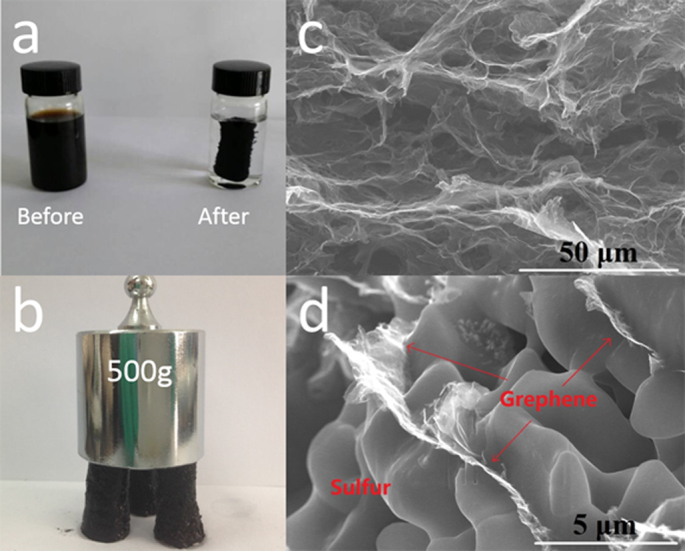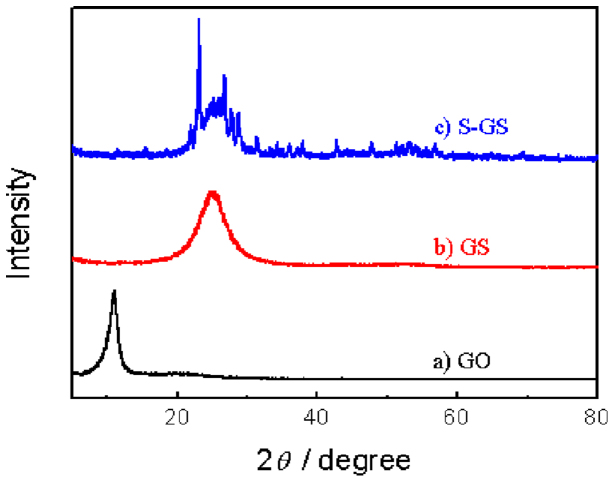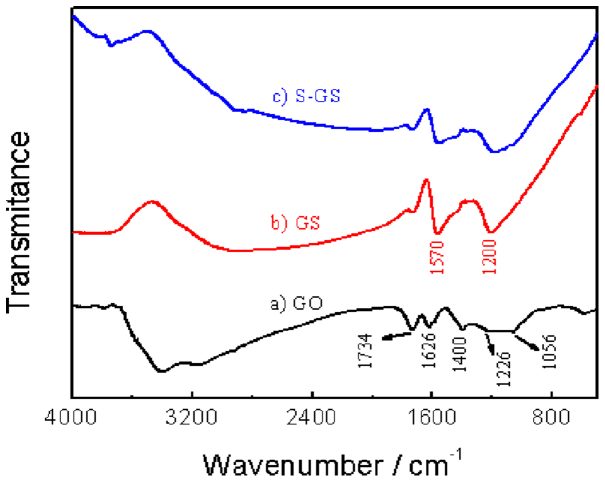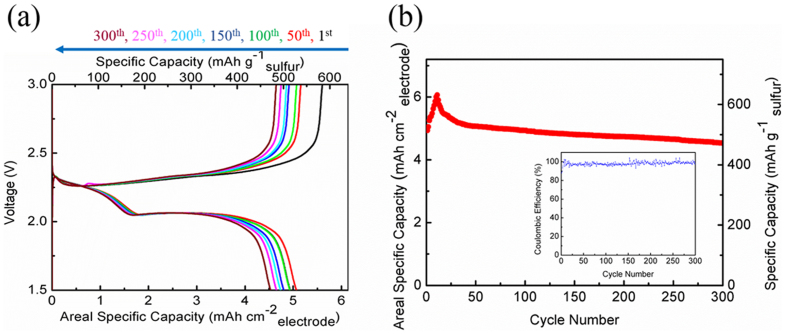Abstract
In this communication, we introduce the concept of three dimensional (3D) battery electrodes to enhance the capacity per footprint area for lithium-sulfur battery. In such a battery, 3D electrode of sulfur embedded into porous graphene sponges (S-GS) was directly used as the cathode with large areal mass loading of sulfur (12 mg cm−2), approximately 6–12 times larger than that of most reports. The graphene sponges (GS) worked as a framework that can provide high electronic conductive network, abilities to absorb the polysulfides intermediate, and meanwhile mechanical support to accommodate the volume changes during charge and discharge. As a result, the S-GS electrode with 80 wt.% sulfur can deliver an extremely high areal specific capacitance of 6.0 mAh cm−2 of the 11th cycle, and maintain 4.2 mAh cm−2 after 300 charge−discharge cycles at a rate of 0.1C, representing an extremely low decay rate (0.08% per cycle after 300 cycles), which could be the highest areal specific capacity with comparable cycle stability among the rechargeable Li/S batteries reported ever.
In recent years, durable, affordable and high energy advanced rechargeable batteries are urgently required because the state-of-the-art energy storage technologies, especially lithium-ion batteries, are critical enabling technologies for the development of advanced, portable electronic devices, electric vehicles, and sustainable energy generation systems1,2. Among these promising energy storage systems for next-generation, lithium-sulfur batteries have received special attentions due to the high theoretical specific capacity (1675 mAh g−1) and high specific energy (2600 Wh kg−1) at a moderate voltage of 2.2 V vs. Li/Li+3,4. In addition, the cathode material elemental sulfur also has other advantages, including its natural abundance, low cost (about $150 per ton), and low environmental impact2,5,6,7,8,9,10,11. However, despite of these advantages, their commercialization are hindered due to the poor cycle performance, which is caused by the natural insulating of sulfur and Li2S, the dissolution and transportation of polysulfide intermediates in the electrolyte, as well as mechanical instability of the electrode caused by volume changes during charging/discharging cycles2,5,6,7,8,9,10,11,12,13,14,15.
Over the past few decades, research and development efforts to address these issues are focused on the improvement of the conductivity and prevention of the polysulfide dissolution and shuttling. Of notable successes, carbon materials (such as graphene9,12,16,17,18,19, carbon nanotubes20,21, carbon nanofibers10,22, carbon sphere)6,23, conductive polymers (such as PEDOT: PSS24) or metal oxides (such as TiO211) are used to modified the sulfur-based cathodes. As a result, high specific capacities exceeding 800 mAh g−1 in terms of sulfur have been achieved by many research groups. However, the commercialized application of the Li-S system hasn't been realized till now, because of that, most of the as-prepared electrodes have extremely low areal mass loading (<2 mg cm−2)9,11,18,24, which will greatly decrease the real capacity of the battery systems and cannot comparable with the commercialized lithium ion batteries, while the typical mass for the lithium ion battery electrode is as high as ~20 mg cm−2 25.
To the best of our knowledge, the highest sulfur loading is reported by Zhang et al., in his paper, the sulfur loading is as high as 12 mg cm−2 26. However, a heavy current collector (carbon cloth, ~14 mg cm−2) was used and the electrochemical performance is really very poor with fast fading rates and low capacity at a current rate of 0.5 mAh cm−2. Most recently, a great deal of work have been done to increase the areal mass loading, including introducing 3D structure electrodes25. In particular, Zhou et al., report a 3D self-assembled graphene-sulfur (G-S) hybrid with good electrical conductivity, showing an outstanding electrochemical properties. It is believed that developing the 3D structures of graphene will play a huge role on lithium sulfur batteries16. Nonetheless, toxic CS2 were used and they did not show how the results will go with increasing of the areal mass loading. Hence, developing facile methods to impregnating sulfur into 3D graphene with high areal mass loading and high capacity is very promising.
In this study, we reported an approach to assemble sulfur- graphene sponge (S-GS) with sulfur uniformly distributed into the pores of graphene sponge that can be directly used as cathode for Li-S batteries with significantly improved areal mass loading and stability. In our approach, self-supporting graphene sponges were firstly obtained using hydrothermal reduction and then sulfur were impregnated into pores of the as-prepared graphene sponges through a heat treatment. In our well-designed structure, porously graphene sponges will not only to improve the overall conductance of the cathode, but also to absorb the soluble polysulfides intermediate.
Results and Discussion
Figure 1a shows the photos of the typical graphene hydrogel easily prepared through hydrothermal reaction. As can be seen from figure 1b, three GO hydrogel can easily support 500 g weight with little deformation, showing comparable mechanical properties to those of chemically cross-linked polymer hydrogels27,28. In addition, the electrical conductivity was measured by four-probe method. With a conductivity of about 42 S/m, it showed an attractive property for many practical applications. The interior microstructures of GO sponges before and after sulfur impregnated were imaged by scanning electron microscope (SEM) of the freeze-dried samples. As it can be seen from figure 1c, the GO sponges shows a well-defined and interconnected 3D porous network and the sizes of the pores are about 3–10 μm. After the emerged of sulfur, showing in figure 1d, the pores are filled with sulfur while the graphene sponge worked as the framework that provide mechanical support and electronic conductive. Moreover, the absorptivity and the surface area of the S-GS were tested, the results showed that the S-GS can absorb electrolyte more than 18 times its weight and the surface areas decreased from 215.12 m2 g−1 to 6.54 m2 g−1, which indicates that the cavity in the electrode is enough to absorb the electrolyte and soluble polysulfides intermediate.
Figure 1. (a) Photographs of a 3.5 mg mL-1 homogeneous GO aqueous dispersion before and after hydrothermal reduction at 180 °C for 18 h; (b) photograph of three strong GO hydrogel allowing supporting weight; (c) SEM image of the interior microstructures of the GO sponges and (d) SEM image of interior microstructures of the S-GS with 80 wt.% sulfur.

X-ray diffraction (XRD) patterns of the GO, GO sponges and S-GS sponges are shown in Figure 2. For GO, a peak appears at 10.9°, which corresponds to an interlayer spacing of 0.81 nm. After the hydrothermal reaction for 18 h, a new peak appears at 26.3° was appeared and instead of this peak, indicating the decreasing of the spacing, which exhibits that after the hydrothermal reaction, the GO was reduced at some degree. For the S-GS, no obvious change of this peak was found when compare with GS and the sulfur showed sharp and strong peaks, indicating that the sulfur was in a well-defined crystal structure, which is also been detonated by the IR analyst, shown in figure 3, after the impregnation of sulfur, no evidence of the C-S bonds were found (νc-s at 987 cm−1), confirming that the sulfur was absorbed by the GO sponges, which agree well with the XRD results.
Figure 2. X-ray diffraction (XRD) patterns of the GO, GS and S-GS with 80 wt.% sulfur.
Figure 3. IR spectra of the GO, GS and S-GS with 80 wt.% sulfur.
In order to clearly identify the possible structural advantages of the graphene sponges on the cycle stability of sulfur, electrochemical performance of the S-CG were evaluated. Figure 4 shows the charge–discharge voltage profiles of the 11th cycle measured during galvanostatic cycled at 0.1C (where 1C corresponds to a current density of 1675 mA g−1) within 1.5 ~ 3.0 V (vs Li+/Li). As can be seen, two plateaus at 2.35 V and 2.05 V were clearly observed during the discharge process, which correspond to the formation of long-chain lithium polysulfides (Li2Sx, 4 ≤ x ≤ 8) and short-chain lithium polysulfides (such as Li2S2 and Li2S), respectively. Such discharge profile is typical for sulfur cathodes2,21. On the basis of the discharge results, the S-GS electrode was able to deliver 6.0 mAh cm−2 of the electrode and 625 mAh g−1 of sulfur in the 11th discharge process. The obtained low gravimetric specific capacity is because of the large areal mass loading of sulfur. As with the previous reported for lithium ion batteries29, thicker electrode cells will be discharged at a higher current density, thus tending to the lower impedance and thicker electrode also places more of a strain on the transport of lithium ions in the electrolyte, thus possibly decrease the gravimetric specific capacity.
Figure 4. The charge–discharge voltage profiles of the 11th cycle for the S-GS cathode measured during galvanostatic cycled at 0.1C.
With continued cycling, as shown in figure 5a, the electrode exhibited well-overlapped and flat plateaus, suggesting good stability and reversibility of the electrode. Figure 5b compares the capacity of the electrode as a function of cycle numbers. Although the initial discharge capacity is relatively low (4.93 mAh cm−2 of the electrode and 513 mAh g−1 of sulfur), it can continued to increase until the 11th cycle (6.0 mAh cm−2 of the electrode and 625 mAh g−1 of sulfur). This behavior can be contributed to the activation step of the S-GS electrode because the surface area of the as-prepared S-GS is low, and therefore, it takes some time for the electrolyte to flood the internal surfaces of the GO sponges. Only under this condition, the deeply buried sulfur and disulfide bonds can contact with the electrolyte and become electrochemically active. Subsequently, the capacities almost stabilized and demonstrated little fading upon extended cycling5. And as a result, the electrode can exhibit a reversible and comparable capacity of 4.53 mAh cm−2 after 300 cycles, corresponding to capacity retention of 75.5% (of its highest capacity of 6.0 mAh cm−2), and the decay rate was as low as 0.08% per cycle for 300 cycles. At the same time, as can be seen from the inserted map in figure 5b, the coulombic efficiency remained at around 98%. On the basis of such superior cyclic stability, it is reasonable to conclude that the graphene sponges framework could effectively improve the cycle stability of the lithium sulfur batteries, likely through absorption and immobilization of the polysulfides intermediate and provide better mechanical support to accommodate the volume changes during charge and discharge.
Figure 5. (a) Charge-discharge profiles at different cycle numbers as labeled; (b) Cyclic performance and coulombic efficiency of the S-GS cathode for Li-S battery at a current density of 0.1C for 300 cycle.
Conclusion
In summary, we have synthesized a 3D electrode of sulfur embedded into porous graphene sponges for lithium sulfur batteries by a heat treatment, which is simple, highly efficient, and scalable. This 3D architecture electrode was able to demonstrate high areal specific capacity and high retention ratio even at a large areal mass loading of ~12 mg sulfur/cm2, approximately 6–12 times higher than that of most reports. The observed high areal specific capacity of the electrode (4.53 mAh cm−2 after 300 cycles) and slow decay rate at 0.1C (0.08% per cycle after 300 cycles) represents a significant step forward for the application of Li−S batteries.
Methods
Synthesis of GO
The graphene oxide was synthesized from natural flake graphite by Hummers' method. The concentration of the GO suspension obtained was ~3.5 mg mL−1, which was determined by drying 20 mL the suspension at 70°C under vacuum for 72 h and then weighing the dried GO.
Synthesis of GO Sponges (GS)
The GO Sponges was prepared by hydrothermal reduction-assembly of homogeneous GO suspension. Briefly, 10 mL of the GO suspension was sealed in a 15-mL Teflon-lined stainless steel autoclave and maintained at 180°C for 18 h. After been cooled to room temperature, black GS hydrogel can be obtained. For GO sponges preparation, the as-prepared graphene hydrogel was freeze-dried to remove absorbed water.
Synthesis of S-GS
The GO sponge was cut and shaped into a circular disc with a diameter of 10 mm (weight of 2.34 mg). Subsequently, appropriate amount of pure sulfur was evenly put on the GO sponge disc and then the sample were put in quartz tubes that were sealed under vacuum. The sulfur impregnation was further carried out by heating the sample in the vacuum-sealed quartz tube under 155°C for 10 h. the weight of the prepared S-GS was 11.68 mg, corresponding the sulfur content in the total cathode is 80% and the areal mass loading of sulfur is ~11.90 mg cm−2.
Materials characterization
The composites were characterized by X-ray diffraction (XRD) with Cu-Ka irradiation, Fourier transform infrared spectra (FT-IR), and four-probe resistivity measurement system. And field emission scanning electron microscope (FESEM) was applied to observe the morphology of the synthesized composite material. Total sulfur loading (~9.34 mg) in the final electrode sample was calculated by weighing the sample before and after sulfur infusion (using a Mettler Toledo MS105DU Semi Micro Balance, 0.01 mg readability and ±0.02 mg repeatability).
Electrochemical measurement
The electrochemical experimental methods used in this work were similar to the ones in our previous study. The S-GS circular disc was used as the cathode directly. 2032 type coin cells were assembled in an argon-filled glove box with lithium foil as the anode. The separator was purchased from Cellgard (model 2400). The electrolyte was 0.1 M lithium nitrate and 1.0 M lithium bis-trifluoromethane sulfonylimide in 1, 3-dioxolane and 1, 2-dimethoxyethane (volume ratio 1:1) (Zhangjiagang Guotai-Huarong New Chemical Materials Co., Ltd). Galvanostatic measurements were conducted using a LAND CT2001A battery test system between 1.5 V and 3.0 V (vs Li+/Li).
Author Contributions
S.T.L. and X.H.W. devised the original concept, designed the experiment, discussed the interpretation of results and co-wrote the paper. S.T.L., Y.C. and Z.D.W. performed the experiments. S.T.L. and Y.L. analysed the dates. All authors reviewed the manuscript.
Acknowledgments
We acknowledge the financial support from the Nature Science Foundation of China (Nos. 51078101, 51173033), and the Fundamental Research Funds for the Central Universities (No.HIT.BRETIII.201224 and 201312).
References
- Shakoor R. A. et al. Site-Specific Transition Metal Occupation in Multicomponent Pyrophosphate for Improved Electrochemical and Thermal Properties in Lithium Battery Cathodes: A Combined Experimental and Theoretical Study. J Am Chem Soc 134, 11740–11748, Doi 10.1021/Ja3042228 (2012). [DOI] [PubMed] [Google Scholar]
- Lu S. T., Cheng Y. W., Wu X. H. & Liu J. Significantly Improved Long-Cycle Stability in High-Rate Li-S Batteries Enabled by Coaxial Graphene Wrapping over Sulfur-Coated Carbon Nanofibers. Nano Lett 13, 2485–2489 (2013). [DOI] [PubMed] [Google Scholar]
- Peramunage D. & Licht S. A Solid Sulfur Cathode for Aqueous Batteries. Science 261, 1029–1032 (1993). [DOI] [PubMed] [Google Scholar]
- Ji X. L. & Nazar L. F. Advances in Li-S batteries. J Mater Chem 20, 9821–9826 (2010). [Google Scholar]
- Xiao L. F. et al. A Soft Approach to Encapsulate Sulfur: Polyaniline Nanotubes for Lithium-Sulfur Batteries with Long Cycle Life. Advanced Materials 24, 1176–1181, DOI 10.1002/adma.201103392 (2012). [DOI] [PubMed] [Google Scholar]
- Zhang C. F., Wu H. B., Yuan C. Z., Guo Z. P. & Lou X. W. Confining Sulfur in Double-Shelled Hollow Carbon Spheres for Lithium-Sulfur Batteries. Angewandte Chemie-International Edition 51, 9592–9595, DOI 10.1002/anie.201205292 (2012). [DOI] [PubMed] [Google Scholar]
- He G., Ji X. L. & Nazar L. High “C” rate Li-S cathodes: sulfur imbibed bimodal porous carbons. Energ Environ Sci 4, 2878–2883, Doi 10.1039/C1ee01219c (2011). [Google Scholar]
- Zhao S. R. et al. A novel porous nanocomposite of sulfur/carbon obtained from fish scales for lithium-sulfur batteries. J Mater Chem A 1, 3334–3339 (2013). [Google Scholar]
- Wang H. L. et al. Graphene-Wrapped Sulfur Particles as a Rechargeable Lithium-Sulfur Battery Cathode Material with High Capacity and Cycling Stability. Nano Lett 11, 2644–2647, Doi 10.1021/Nl200658a (2011). [DOI] [PubMed] [Google Scholar]
- Zheng G. Y., Yang Y., Cha J. J., Hong S. S. & Cui Y. Hollow Carbon Nanofiber-Encapsulated Sulfur Cathodes for High Specific Capacity Rechargeable Lithium Batteries. Nano Lett 11, 4462–4467, Doi 10.1021/Nl2027684 (2011). [DOI] [PubMed] [Google Scholar]
- Seh Z. W. et al. fSulphur-TiO2 yolk-shell nanoarchitecture with internal void space for long-cycle lithium-sulphur batteries. Nat Commun 4, Artn 1331Doi 10.1038/Ncomms2327 (2013). [DOI] [PubMed] [Google Scholar]
- Xu H. et al. Graphene-encapsulated sulfur (GES) composites with a core-shell structure as superior cathode materials for lithium-sulfur batteries. J Mater Chem A 1, 15142–15149 (2013). [Google Scholar]
- Wu F., Chen J. Z., Li L., Zhao T. & Chen R. J. Improvement of Rate and Cycle Performence by Rapid Polyaniline Coating of a MWCNT/Sulfur Cathode. J Phys Chem C 115, 24411–24417, Doi 10.1021/Jp207893d (2011). [Google Scholar]
- Liang X. et al. A composite of sulfur and polypyrrole-multi walled carbon combinatorial nanotube as cathode for Li/S battery. J Power Sources 206, 409–413, DOI 10.1016/j.jpowsour.2012.01.123 (2012). [Google Scholar]
- Li W. Y. et al. High-performance hollow sulfur nanostructured battery cathode through a scalable, room temperature, one-step, bottom-up approach. P Natl Acad Sci USA 110, 7148–7153 (2013). [DOI] [PMC free article] [PubMed] [Google Scholar]
- Zhou G. M. et al. Fibrous Hybrid of Graphene and Sulfur Nanocrystals for High-Performance Lithium-Sulfur Batteries. Acs Nano 7, 5367–5375 (2013). [DOI] [PubMed] [Google Scholar]
- Jin J. et al. Flexible self-supporting graphene-sulfur paper for lithium sulfur batteries. Rsc Adv 3, 2558–2560 (2013). [Google Scholar]
- Ji L. W. et al. Graphene Oxide as a Sulfur Immobilizer in High Performance Lithium/Sulfur Cells. J Am Chem Soc 133, 18522–18525, Doi 10.1021/Ja206955k (2011). [DOI] [PubMed] [Google Scholar]
- Li N. W. et al. High-rate lithium-sulfur batteries promoted by reduced graphene oxide coating. Chem Commun 48, 4106–4108, Doi 10.1039/C2cc17912a (2012). [DOI] [PubMed] [Google Scholar]
- Chen J. J. et al. A hierarchical architecture S/MWCNT nanomicrosphere with large pores for lithium sulfur batteries. Phys Chem Chem Phys 14, 5376–5382, Doi 10.1039/C2cp40141j (2012). [DOI] [PubMed] [Google Scholar]
- Dorfler S. et al. High capacity vertical aligned carbon nanotube/sulfur composite cathodes for lithium-sulfur batteries. Chem Commun 48, 4097–4099 (2012). [DOI] [PubMed] [Google Scholar]
- Rao M. M., Geng X. Y., Li X. P., Hu S. J. & Li W. S. Lithium-sulfur cell with combining carbon nanofibers-sulfur cathode and gel polymer electrolyte. J Power Sources 212, 179–185, DOI 10.1016/j.jpowsour.2012.03.111 (2012). [Google Scholar]
- Schuster J. et al. Spherical Ordered Mesoporous Carbon Nanoparticles with High Porosity for Lithium-Sulfur Batteries. Angewandte Chemie-International Edition 51, 3591–3595, DOI 10.1002/anie.201107817 (2012). [DOI] [PubMed] [Google Scholar]
- Yang Y. et al. Improving the Performance of Lithium-Sulfur Batteries by Conductive Polymer Coating. Acs Nano 5, 9187–9193, Doi 10.1021/Nn203436j (2011). [DOI] [PubMed] [Google Scholar]
- Hu L. B. et al. Lithium-Ion Textile Batteries with Large Areal Mass Loading. Adv Energy Mater 1, 1012–1017 (2011). [Google Scholar]
- Zhang S. S. & Tran D. T. A proof-of-concept lithium/sulfur liquid battery with exceptionally high capacity density. J Power Sources 211, 169–172 (2012). [Google Scholar]
- Xu Y. X., Sheng K. X., Li C. & Shi G. Q. Self-Assembled Graphene Hydrogel via a One-Step Hydrothermal Process. Acs Nano 4, 4324–4330 (2010). [DOI] [PubMed] [Google Scholar]
- Chen W. F. & Yan L. F. In situ self-assembly of mild chemical reduction graphene for three-dimensional architectures. Nanoscale 3, 3132–3137 (2011). [DOI] [PubMed] [Google Scholar]
- Lu W. Q. et al. High-energy electrode investigation for plug-in hybrid electric vehicles. J Power Sources 196, 1537–1540 (2011). [Google Scholar]






